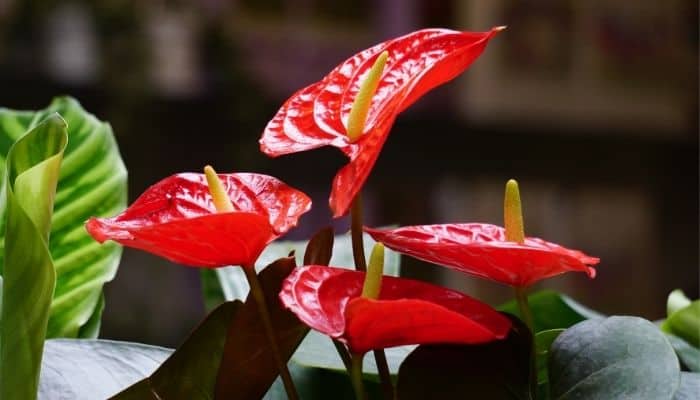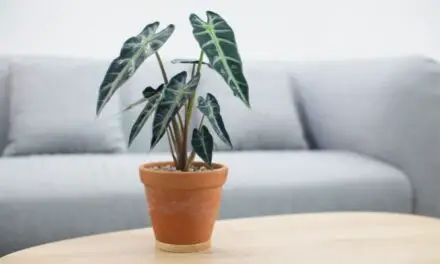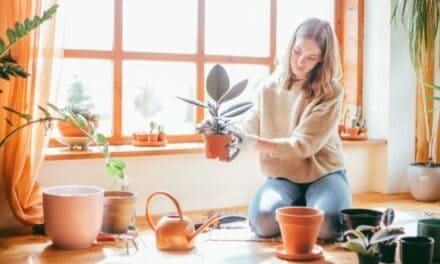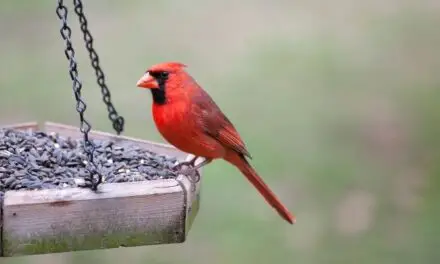Native to the tropical regions of South and Central America, anthuriums feature large, green, heart-shaped leaves with brightly colored, glossy flowers.
They make a stunning houseplant that can be constantly kept in bloom and they are not too difficult to look after, as long as you are aware of a few of their specific needs.
One of the most common issues that people face with these plants is the browning of their leaves.
There can be a few reasons why this happens so let’s jump in and take a look in more detail.
Table of Contents
Why Is My Anthurium Leaves Turning Brown?

Your anthurium’s leaves are turning brown because either its soil is too dry, it’s not receiving enough humidity, it has been sunburned, waterlogged, not fertilized, deficient in nutrients or it is simply getting older and its old leaves are naturally turning brown and dying back.
There can be many reasons for your anthurium’s leaves to begin turning brown.
The good news is that you should be able to get your plant back into great health again if you can identify the problem and at quickly.
Let’s look a little closer at some of these causes and what you can do to fix them.
Soil And Humidity Issues
Soil
The combination of low humidity and dry soil may cause the leaves of your anthurium to turn brown.
These plants do best in a light and fast-draining potting mixture.
Out-of-the-box, standard soils are usually far too heavy and don’t provide enough drainage.
Many experts who grow anthuriums successfully recommend a potting mixture as follows:
- 30% Miracle-Gro moisture control.
- 20% good-quality peat moss.
- 40% orchid mix.
- 10% gravel, charcoal, bark, perlite.
This mixture will make it easy for water to drain away from the plant’s roots while holding onto just a tiny bit of moisture.
Humidity
Anthuriums are from the tropics and do prefer higher humidity levels (somewhere in the region of 77% – 88%).
But they can handle lower levels of humidity if you water them regularly.
Just always make sure that they are in fast-draining soil and a pot with good drainage so that their soil never gets soggy.
You could also get a humidifier or keep your anthurium in a bathroom, where there’s higher humidity than in other rooms.
Also Read: Will Anthurium Grow In Water? (Explained)
Sunburn
Anthuriums are epiphytes that mostly grow on other trees in the dappled sunlight beneath the canopy of a forest.
They don’t get direct sun in their native environment and do best with indirect sunlight that is not too bright or intense.
These plants can tolerate lower light conditions.
If you leave them in full sun, their leaves will scorch and turn brown.
Indirect sunlight is best but you still need to be careful. These plants are sensitive to sunlight and too much bright light – either direct or indirect – will stress them.
The best way to judge whether or not your anthurium is getting the right amount of sunlight is to keep an eye on your plant’s color.
If you’re giving your anthurium lots of indirect sunlight and its leaves are staying a rich, dark green color, then that indicates that it’s getting the right amount of light.
On the other hand, if your plant is beginning to look totally bleached out, then its color is fading because it is receiving too much bright sunlight.
And when exposed to direct sunlight, especially after long periods in shade, they are prone to sunburn.
You will know for sure that your plant is sunburned if all the leaves turn brown or yellow at once.
To prevent further sunburn, move it to a less sunny spot.
If your living space gets a lot of direct sunlight all day and you are having trouble finding a less sunny spot for it, try using a sheer curtain so that your plant can get more indirect light.
Natural Aging
Like all plants, at some point, your anthurium will have to lose some leaves due to age.
Very few plants can keep their leaves throughout their whole life cycle.
The odd leaf turning brown and dropping off is probably not a cause for concern.
This will make your plant look healthier and provide space for new growth.
Waterlogging
Waterlogging is a major problem for these plants because it stops the roots from getting air and leads to root rot.
If your anthurium is left to sit in standing water, its leaves will turn brown as it begins to rot and die.
Also, make sure to use a pot that has good drainage so that all excess water is allowed to drain out.
The best type of pot for your anthurium is an open pot – something like a black plastic net pot that has lots of holes all the way around and underneath.
This allows for great drainage and loads of air for the roots.
You can also use a drip tray and pour away any standing water.
What To Do If Your Plant Is Rotting
If you notice that the roots of your anthurium look blackened, slimy, or squishy, you will need to act quickly to save your plant.
This is probably a result of your plant sitting in water and the best course of action is to remove it from its current pot, remove any portions of the root that look damaged, and repot it in fresh, fast-draining soil.
These plants can handle a fair bit of watering, as long as they are in fast-draining soil in a pot with good drainage.
Aim to water your plant about once every 3 days and do not let it dry out too much.
Nutrient Deficiency
Brown leaves on your anthurium may also be a sign of nutrient deficiency.
These plants need phosphorous, nitrogen, and potassium to thrive and be healthy.
To prevent nutrient deficiency, you can use a slow-release fertilizer like a fertilizer spike to make sure that your plant gets adequate nutrients over a long period of time.
If your anthurium starts to get brown leaves and you want a fast-acting fertilizer, you can use a liquid fertilizer.
To fertilize it, dilute the fertilizer to 25% of its strength, and feed it every few months.
The smaller your plant is the less fertilizer it will need.
Also, these plants need less fertilizer when grown in cooler climates.
If you notice that the lower leaves of your anthurium are turning brown or yellow, you have probably over-fertilized it.
If you do over-fertilize, you’ll have to flush out your plant’s pot and cut back on the amount you are using.
Final Thoughts
Once you get accustomed to the needs of anthuriums, they make a great low-maintenance houseplant.
If you do notice the leaves turning brown, it is most likely a moisture issue.
Make sure it’s in the right potting mix, not getting too much sunlight, and not being allowed to dry out too much.




